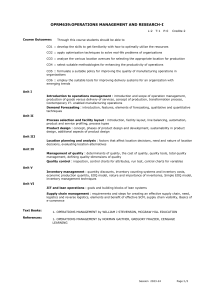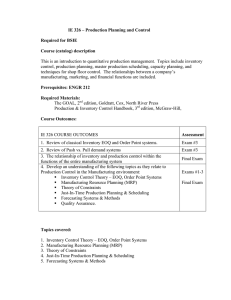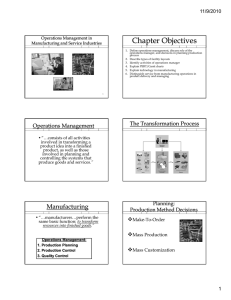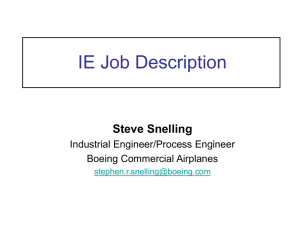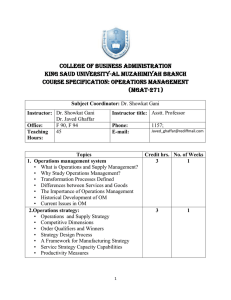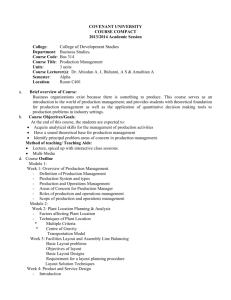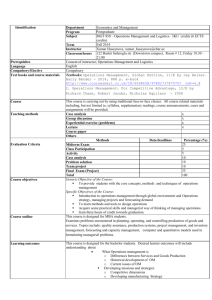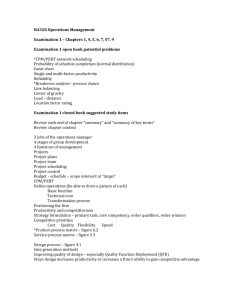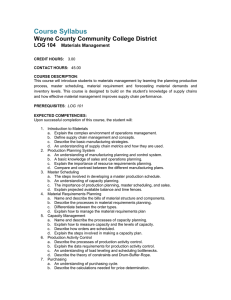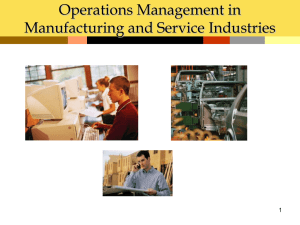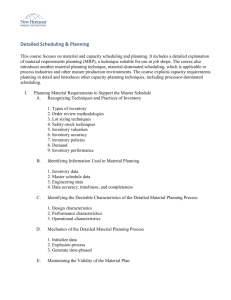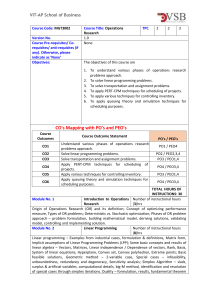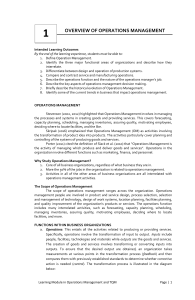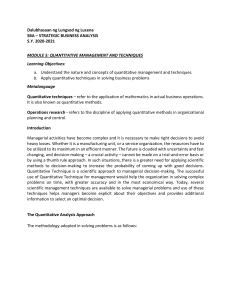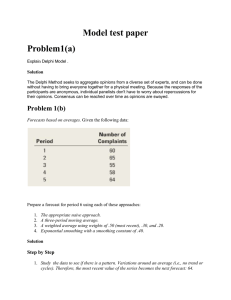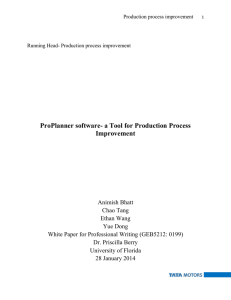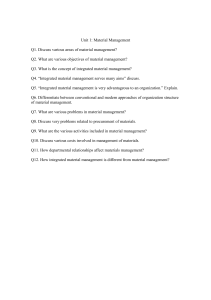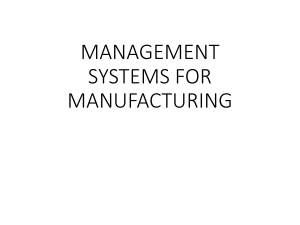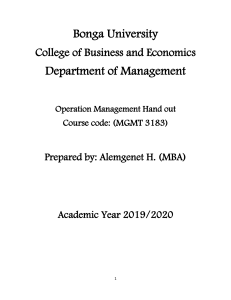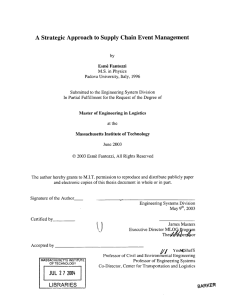OM-Course plan.
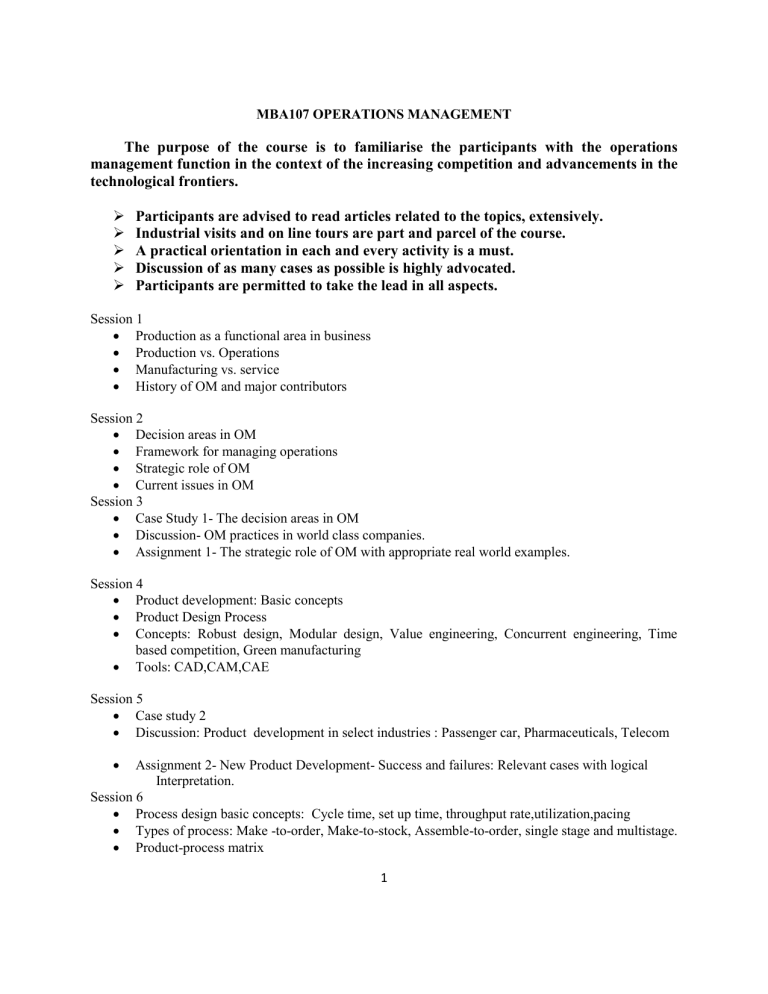
MBA107 OPERATIONS MANAGEMENT
The purpose of the course is to familiarise the participants with the operations management function in the context of the increasing competition and advancements in the technological frontiers.
Participants are advised to read articles related to the topics, extensively.
Industrial visits and on line tours are part and parcel of the course.
A practical orientation in each and every activity is a must.
Discussion of as many cases as possible is highly advocated.
Participants are permitted to take the lead in all aspects.
Session 1
Production as a functional area in business
Production vs. Operations
Manufacturing vs. service
History of OM and major contributors
Session 2
Decision areas in OM
Framework for managing operations
Strategic role of OM
Current issues in OM
Session 3
Case Study 1- The decision areas in OM
Discussion- OM practices in world class companies.
Assignment 1- The strategic role of OM with appropriate real world examples.
Session 4
Product development: Basic concepts
Product Design Process
Concepts: Robust design, Modular design, Value engineering, Concurrent engineering, Time based competition, Green manufacturing
Tools: CAD,CAM,CAE
Session 5
Case study 2
Discussion: Product development in select industries : Passenger car, Pharmaceuticals, Telecom
Assignment 2- New Product Development- Success and failures: Relevant cases with logical
Interpretation.
Session 6
Process design basic concepts: Cycle time, set up time, throughput rate,utilization,pacing
Types of process: Make -to-order, Make-to-stock, Assemble-to-order, single stage and multistage.
Product-process matrix
1
Session 7
Productivity: measurement, importance
Flow charts
Case Study 3.
Discussion: Process design at: a kirana, stationary shop, supermarket and organized retail outlet
Assignment 3-Prepare the flow charts of 5 different processes.
Session 8
Lay out design: Basic concepts
Types: Advantages and disadvantages of each
Line balancing, sequencing
Session 9
Case study 4
Discussion: Layout of your class room, Layout of a modern retail outlet, a shopping mall and a multispecialty hospital.
Assignment 4-“Facility layout is also a marketing problem in services”. Substantiate.
Industrial visit- Critically evaluate the process design and layout of the facility.
Session 10
Facility Location:Importance,Focus
Factors affecting location decision
BPO
Session 11
Methods for location selection: Factor rating, Break-even analysis, Centre of Gravity,
Transportation
Numerical problems
Session 12
Environmental Impact Assessment
Bio diversity and sensitivity
Sustainable and Responsible Development
Case Study 5
Discussion: Tata-Singur, Narmada Bachavo Andolan, Plachimada issues
Assignment 5: Review on major industrial belts in India.
Session 13
Inventory Management: Importance
Inventory classification: ABC,VED,FSN,GOLF,XYZ,HML,SDE
Components of inventory cost: Item cost, ordering cost, carrying cost, set up cost
Session 14
Inventory models: Simple EOQ,EOQ with quantity discounts,Probabilistic models
Numerical problems
2
Session 15
Purchasing:centralized vs.decentralised, Tenders,quotations, CPC
Stores management: coding,cycle counting,inspection,sampling
P System and Q system
Vender Management
Session 16
Materials Requirement Planning(MRP-I)
Manufacturing Resource Planning(MRP-II)
Enterprise Resource Planning(ERP)
Case study 6.
Assignment 6: Work out problems on inventory models
Session 17
Quality Management; Definitions
Cost of quality
Quality Gurus
Strategic role of quality
Session 18
Quality system standards: ISO 9000, ISO14000
BIS:Role and responsibilities.
Statistical Process Control(SPC): Control chart for variables and attributes
Acceptance sampling ; OC Curve, AQL,LTPD
Session 19
TQM:Concepts,Pyramid
TQM Tools
Session 20
Case study 7
Discussion: Japanese management and quality
Assignment 7: Discuss the quality concepts mooted by the ‘Gurus’ from time to time.
Session 21
Supply Chain Management: Concepts
Views: Push-pull view, Cyclic view
Vertical Integration
Session 22
Case Study 8
Assignment 8: e-SCM models used by leading companies
Discussion: Emerging trends in SCM
Session 23
Job design: Use of labor standards
Work study
Labour specialization, Job expansion, Self Directed Teams
3
Session 24
Time study methods: Direct time study, work sampling
Numerical problems
Case Study 9
Assignment 9: Problems on Time Study
Session 25
Maintenance management and Reliability
Cost of maintenance
Toyota Production System
Session 26
Total Productive Maintenance(TPM)
Case study 10
Discussion: Emerging trends in Maintenance management
Assignment 10: Read the book “The Toyota Way” and submit a summary.
Session 26
Scheduling Decision
Capacity planning: concepts, importance
Aggregate Production Planning
Capacity options: Demand option supply option, mixed options
Session 27
Short term scheduling: importance
Forward and backward scheduling, sequencing
Theory of Constraints
Case study 11
Session 28
Project Management
Project planning, scheduling and controlling,
PERT and CPM
Assignment 11: Problems on PERT and CPM
Session 29
Simulation
Queuing
Transportation
Session 30
World Class Manufacturing
Lean Manufacturing, Agile Manufacturing
Computer Integrated Manufacturing(CIM)
Assignment 12: World Class Manufacturing Practices.
Session 30- 40
Seminars
4
5

